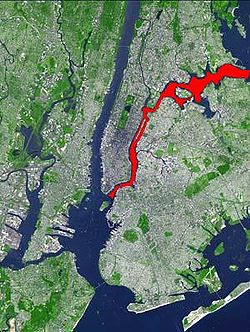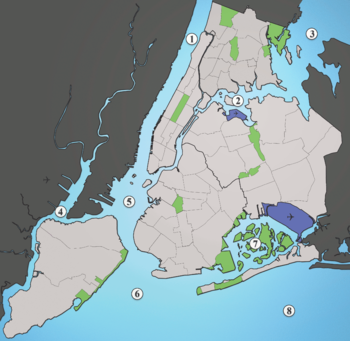This is an old revision of this page, as edited by VerruckteDan (talk | contribs) at 01:00, 2 October 2006. The present address (URL) is a permanent link to this revision, which may differ significantly from the current revision.
Revision as of 01:00, 2 October 2006 by VerruckteDan (talk | contribs)(diff) ← Previous revision | Latest revision (diff) | Newer revision → (diff)- This article is about the East River in New York City. For other uses, see East River (disambiguation).



The East River is a tidal strait in New York City connecting Upper New York Bay on its south end to Long Island Sound on its north end. It separates Long Island (including the boroughs of Queens and Brooklyn) from the island of Manhattan and the Bronx on the North American mainland.
In reference to its connection to Long Island Sound, it was once also known as the Sound River.
The Channel
Historically, the lower portion of the river (separating Manhattan from Brooklyn) was one of the busiest and most important channels in the world, particularly during the first three centuries of New York City's history. The Brooklyn Bridge, opened in 1883, was the first bridge to span the river, replacing frequent ferry service. (Some passenger ferry service remains between Queens and Manhattan.)
The Bronx River drains into the East River in the northern section of the strait.
North of Ward's Island, it is joined by the Bronx Kill. Along the east of Ward's Island, at approximately the strait's midpoint, it narrows into a channel called Hell Gate, which is spanned by both the Triborough Bridge and the Hell Gate Bridge. On the south side of Ward's Island, it is joined by the Harlem River.
Newtown Creek on Long Island drains into the East River, forming part of the boundary between Queens and Brooklyn.
The East River contains a number of islands, including:
- Upper section
- Lower Section
- Ward's Island and Randall's Island (joined by landfill)
- Roosevelt Island
- U Thant Island (Belmont Island)
Crossings
See also List of crossings of the East River
Bridges
The river is spanned by eight bridges, which from north to south are:
- Throgs Neck Bridge
- Bronx-Whitestone Bridge
- Rikers Island Bridge (From Queens to Rikers Island only)
- Hell Gate Bridge
- Triborough Bridge (East River Suspension Span)
- Roosevelt Island Bridge (east channel only)
- Queensboro Bridge
- Williamsburg Bridge
- Manhattan Bridge
- Brooklyn Bridge.
Tunnels
The river is spanned by thirteen tunnels. From north to south, along with uses as of July 2006:
- 63rd Street Tunnel (Trains of the F and <F> subway service)
- 60th Street Tunnel (Trains of the N, R, and W subway services)
- 53rd Street Tunnel (Trains of the E and M subway services)
- Steinway Tunnel (Trains of the 7 and <7> subway service)
- Queens Midtown Tunnel (Vehicular traffic of Interstate 495)
- East River Tunnels (Long Island Railroad and Amtrak trains from Penn Station to points north and east)
- 14th Street Tunnel (Trains of the L subway service)
- Rutgers Street Tunnel (Trains of the F and <F> subway service)
- Cranberry Street Tunnel (Trains of the A and C subway services)
- Clark Street Tunnel (Trains of the 2 and 3 subway services)
- Montague Street Tunnel (Trains of the N, R, and W subway services)
- Joralemon Street Tunnel (Trains of the 4 and 5 subway services)
- Brooklyn-Battery Tunnel (Vehicular traffic of Interstate 478)
See also
External links
- East River page from the Greater Astoria Historical Society
- LIC Community Boathouse site for free paddling on the East River
- Western Queens waterfront information page